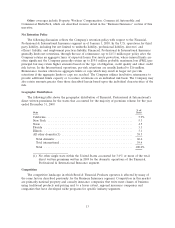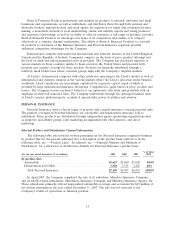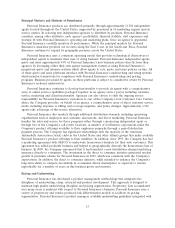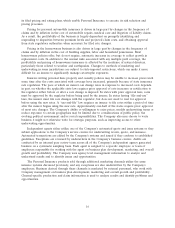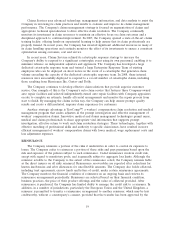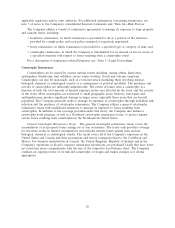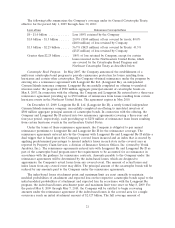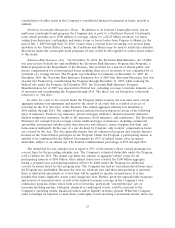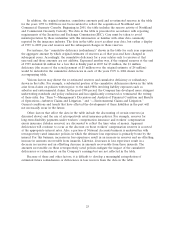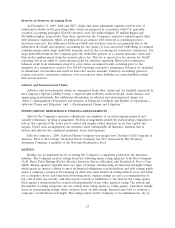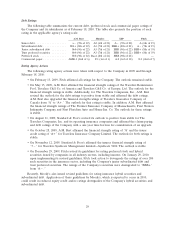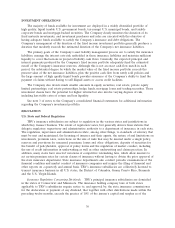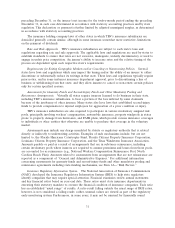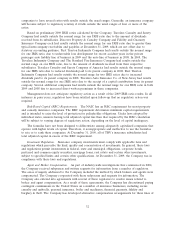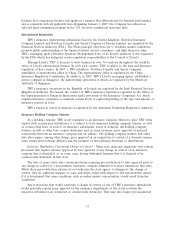Travelers 2009 Annual Report Download - page 35
Download and view the complete annual report
Please find page 35 of the 2009 Travelers annual report below. You can navigate through the pages in the report by either clicking on the pages listed below, or by using the keyword search tool below to find specific information within the annual report.consolidation of either entity in the Company’s consolidated financial statements in future periods is
unlikely.
Northeast Catastrophe Reinsurance Treaty. In addition to its General Catastrophe treaty and its
multi-year catastrophe bond program, the Company also is party to a Northeast General Catastrophe
treaty which provides up to $500 million of coverage, subject to a $2.25 billion retention, for losses
arising from hurricanes, earthquakes and winter storm or freeze losses from Virginia to Maine for the
period July 1, 2009 through June 30, 2010. Losses from a covered event (occurring over several days)
anywhere in the United States, Canada, the Caribbean and Mexico may be used to satisfy the retention.
Recoveries under the catastrophe bond programs (if any) would be first applied to reduce losses subject
to this treaty.
Terrorism Risk Insurance Acts. On November 26, 2002, the Terrorism Risk Insurance Act of 2002
was enacted into Federal law and established the Terrorism Risk Insurance Program (the Program), a
Federal program in the Department of the Treasury, that provided for a system of shared public and
private compensation for certain insured losses resulting from acts of terrorism or war committed by or
on behalf of a foreign interest. The Program was scheduled to terminate on December 31, 2005. In
December 2005, the Terrorism Risk Insurance Extension Act of 2005 (the Terrorism Extension Act) was
enacted into Federal law, reauthorizing the Program through December 31, 2007, while reducing the
Federal role under the Program. In December 2007, the Terrorism Risk Insurance Program
Reauthorization Act of 2007 was enacted into Federal law, extending coverage to include domestic acts
of terrorism and reauthorizing the Program through 2014. The three acts are hereinafter collectively
referred to as ‘‘the Acts.’’
In order for a loss to be covered under the Program (subject losses), the loss must meet certain
aggregate industry loss minimums and must be the result of an event that is certified as an act of
terrorism by the U.S. Secretary of the Treasury. The annual aggregate industry loss minimum is
$100 million through 2014. The original Program excluded from participation certain of the following
types of insurance: Federal crop insurance, private mortgage insurance, financial guaranty insurance,
medical malpractice insurance, health or life insurance, flood insurance, and reinsurance. The Terrorism
Extension Act exempted from coverage certain additional types of insurance, including commercial
automobile, professional liability (other than directors and officers’), surety, burglary and theft, and
farm-owners multi-peril. In the case of a war declared by Congress, only workers’ compensation losses
are covered by the Acts. The Acts generally require that all commercial property and casualty insurers
licensed in the United States participate in the Program. Under the Program, a participating insurer is
entitled to be reimbursed by the Federal Government for 85% of subject losses, after an insurer
deductible, subject to an annual cap. The Federal reimbursement percentage is 85% through 2014.
The deductible for any calendar year is equal to 20% of the insurer’s direct earned premiums for
covered lines for the preceding calendar year. The Company’s estimated deductible under the Program
is $2.14 billion for 2010. The annual cap limits the amount of aggregate subject losses for all
participating insurers to $100 billion. Once subject losses have reached the $100 billion aggregate
during a program year, participating insurers will not be liable under the Program for additional
covered terrorism losses for that program year. The Company has had no terrorism-related losses since
the Program was established. Because the Acts are relatively new and their interpretation is untested,
there is substantial uncertainty as to how they will be applied to specific circumstances. It is also
possible that future legislative action could change the Acts. Further, given the unpredictable frequency
and severity of terrorism losses, as well as the limited terrorism coverage in the Company’s own
reinsurance program, future losses from acts of terrorism, particularly ‘‘unconventional’’ acts of
terrorism involving nuclear, biological, chemical or radiological events, could be material to the
Company’s operating results, financial position and/or liquidity in future periods. While the Company
seeks to manage its exposure to man-made catastrophic events involving conventional means, there can
23


